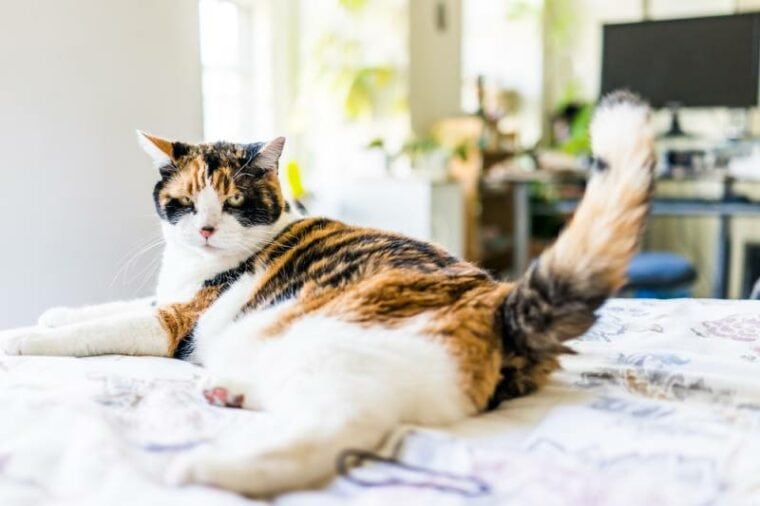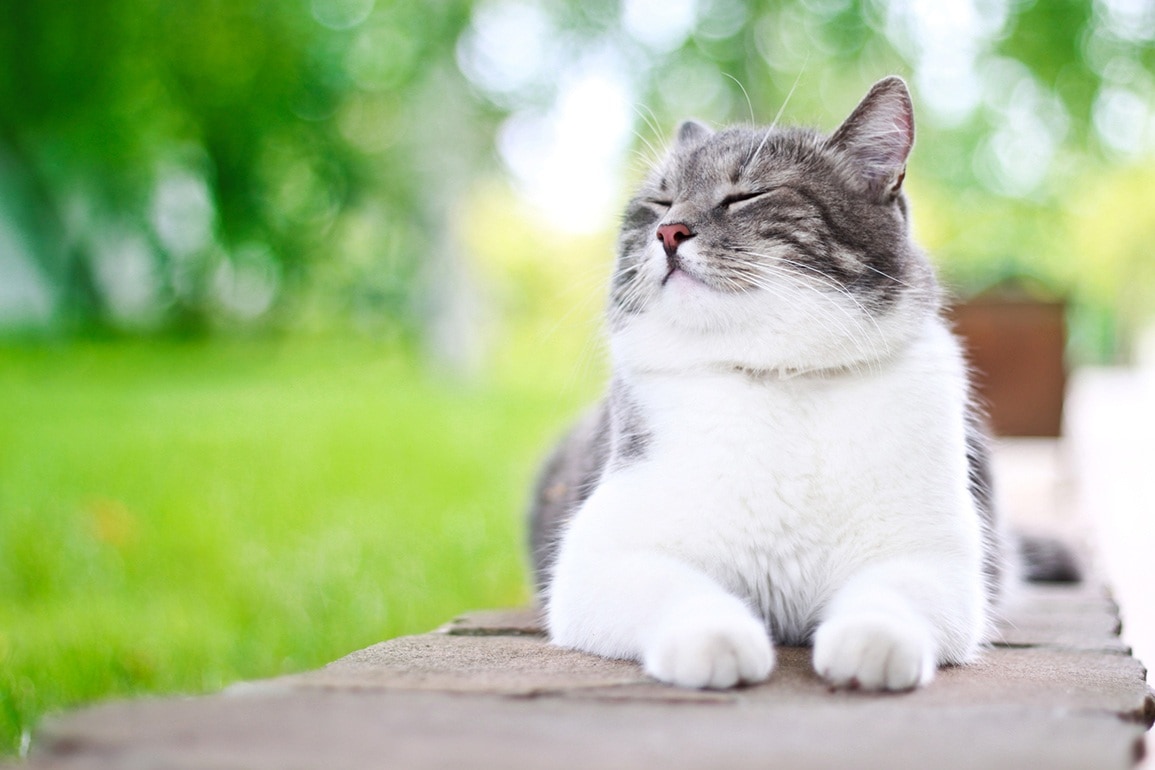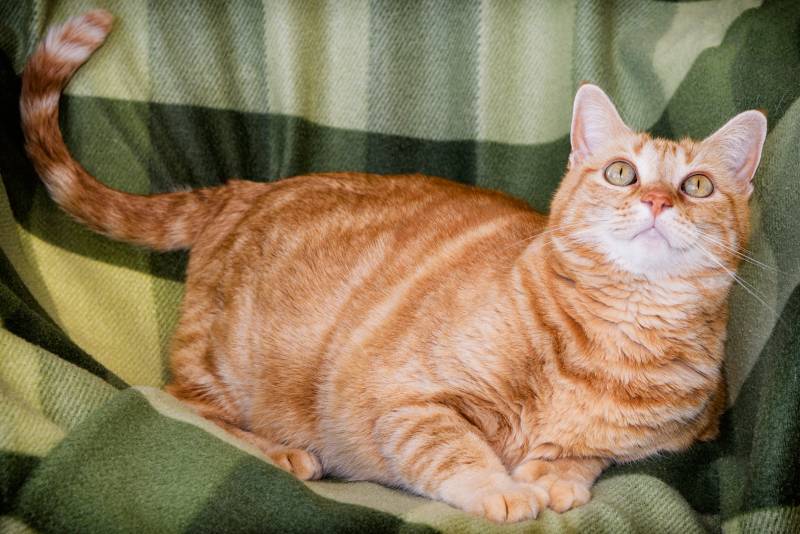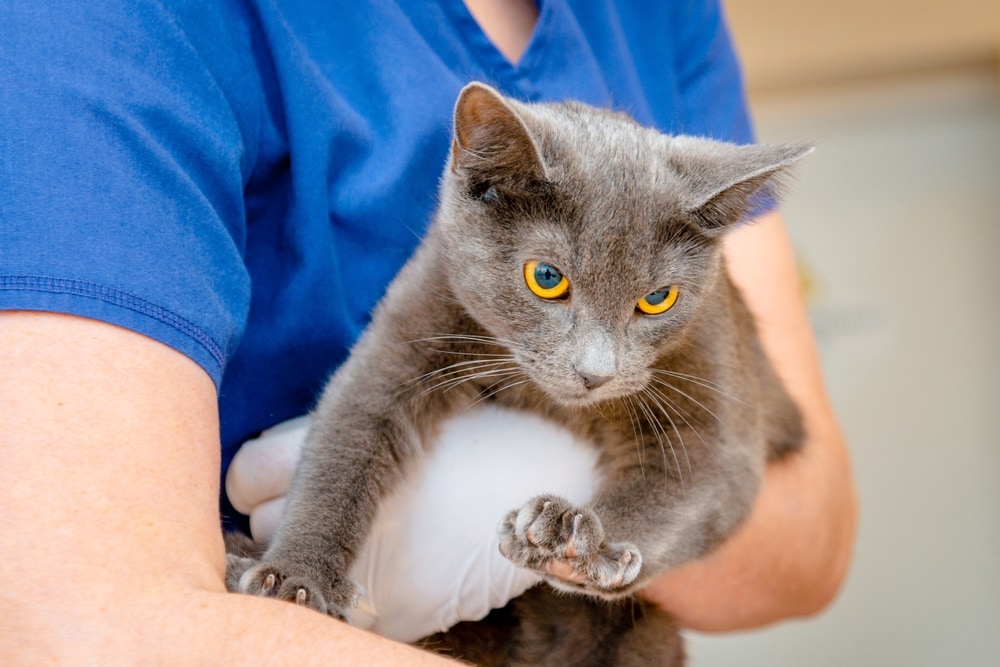
Cats are amazing creatures: they can lift our spirits with a single meow. And let’s not forget about the tail wagging! If you’ve had a hard day at work, a kitty greeting you with a wagging tail can make it all worth it. Cats thump their tails when they’re happy, excited, and playful. Or, it could be a sign that the kitty is having a dream.
But sometimes, a thumping tail also means the cat is in a bad mood or coping with pain. Felines are masters of disguise and don’t like to show it when they’re hurting. So, how do you know if the pet is happy or struggling? Let’s find out!

The 7 Reasons Why Cats Thump Their Tails
1. The Cat Is Genuinely Happy!

A happy bunny does the binky; a cheerful dog likes to dance, wiggle, and bark in enjoyment. As for cats, when relaxed and joyful, they often slowly thump their tails. For example, if you show the cat love by scratching under its chin or moving your hand along the back, and the fur baby responds by gently wagging its tail, rest assured the bud is enjoying the petting.
And if that’s accompanied by vocalizations (like a content purr) and constant blinking, that means the pet is in cat heaven. It’s very important to watch out for these little things to make sure the cat is, indeed, happy with the petting, though. As we’ll learn in a moment, tail thumping can also mean it’s upset or in pain.
2. The Pet Is Excited About Something
A tasty meal, a brand-new toy, or a fellow feline—anything can get a cat excited! Watch closely: if the kitty is wagging its tail while running toward a bowl of food or playing around with a new toy, most likely, it’s a thrilling experience for it. Excited cats often act on impulse: they sit in the corner peacefully for a while and then zip or zoom across the room when an object of interest falls into their radar.1
Curiosity is one of the biggest driving forces behind a cat’s actions. And the thumping tail is a sign that it’s not frightened, uncomfortable, or anxious—just inquisitive. Also, while most cats enjoy being pets, they often build up bursts of energy with no “targets” for it. That’s why these speedy, Flash-like movements are normal for domestic felines.
3. The Fur Baby Is Welcoming You Back

If you have a strong bond with the cat and it doesn’t like to be left alone, it might stick around at the door for hours, waiting for your return. Or, it will come running toward you the second you open the front door. And a thumping or elevated tail will be the pet’s way of saying it’s happy to see its favorite human. A cat that’s willing to put a stop to important feline business just to greet you is a keeper!
A gentle meow and lots of head rubs could also be a part of the “welcome committee”. Now, some cats aren’t nearly as affectionate and just give you a slight thump or two while enjoying a nap to recognize your presence. Well, that’s still a sign of love and care. Most balls of fur expect you to make the first move, not the other way around.
4. The Pet Is In the Mood to Hunt or Play
Do you want to play with your cat but aren’t sure if it’s up for it? Then watch the tail! A feline that’s lying comfortably on its stomach and moving its tail from left to right is a pet that’s ready to play. Usually, they just wag their tails, but an occasional thump or two will also be a part of the routine. If this is happening outdoors, we bet the cat is stalking its prey.
It can be a rodent, bird, or even an insect. The tail thumping (also known as swishing) helps the cat maintain perfect balance before making a jump and striking. Felines do this stalking stance indoors as well. To keep it entertained, offer the pet to play with its favorite toys. Be gentle, take it slow, and let the cat determine the pace.
5. It’s a Sign the Cat’s Is in REM Sleep

Humans have five stages of sleep, while cats only go through two phases. We’re talking about NREM and REM. Now, NREM (non-rapid eye movement) is the light phase, like a catnap, while REM (rapid eye movement) is the deep phase—that’s when the body gets the much-needed rest. So, what do cats do in their sleep? They twitch, wiggle, and make all kinds of cute noises.
That means the fur baby is in the Dreamland. A wagging tail is another common “side effect” of REM sleep. So, if the pet’s eyes are moving while the lids are closed and the tail is thumping, you’ve got yourself a dreamer! Resist the urge to pet the cat while it’s catching Z’s, as that will disturb and confuse it. Oh, and by the way, cats need 12–18 hours of rest per day.
6. Your Feline Friend Is Frustrated
We want the best for our cats, but sometimes, we end up annoying the four-legged family members, and they’re quick to show their frustration. Therefore, if you’re trying to pet the kitty, yet it runs away while keeping its tail up, that just means the “vibes” are not there. Or, maybe the cat is unhappy about something that you did recently, and the thumping is its way of showing that.
The worst thing you can do in this situation is force the petting. If you keep at it, the cat will start hissing, growling, and might even scratch your hands! Instead, just let the cat go on about its day. So, what’s causing this? Well, it could be a bad meal, chilly weather, or something entirely different. The important part is, when the time is right, the fluffy companion will come back for its fair share of cuddles. Just be patient.
7. It Could Be Dealing With Pain

Cats have been domesticated for thousands of years, yet they still haven’t lost their survival instincts. And that’s why our furry buds hide their pain: in the wilderness, a weak, hurt, or disabled feline is a prime target for predators. Unfortunately, that means the cat can be dealing with excruciating pain, yet you won’t suspect anything. But, if you look closely at the pet’s tail, it could give the kitty up.
Chaotic, spontaneous wagging of the tail often means the pet is hurting. It’s a reflex, something that the pet has little control over. To be sure, watch out for other signs, including a bad appetite, aggressive behavior, and drowsiness. Cats in pain don’t usually lie comfortably on the couch; instead, they get restless. The best course of action here would be to take the cat to an animal doctor.

Quivering and Twitching: Deciphering the Cat Tail Language
For a cat, the tail is more than just an extra limb. First, it helps the beast’s body maintain a balance when running or climbing. On top of that, the tail keeps the cat warm, scares off mosquitoes, and aids in marking territory. More importantly, the tail is a great communication tool for our furry friends. Earlier, we talked about thumping. And here’s a quick look at other common tail positions and what they mean:

Why Do Felines Puff Up Their Tails?
What do cats do when they’re scared of something (or, rather, someone)? They either run away or stand their ground. A feline that decides to face the danger arches its back and puffs its tail to appear bigger. The reason for this is simple: to scare the predator away. This happens all the time with feral cats, but domestic kitties do this as well.
For example, if you welcome a new pet (especially a dog) into the house or have some folks over that the feline has never seen, it might puff up its tail. How do you deal with this, then? By making the environment safer for the cat, of course (like taking the strangers to a different room). A common mistake that many owners make is trying to pet the feline and make it calm down. But that will only trigger it more!
The Question Mark Tail: What Does It Mean?
Often called the “hook tail”, it’s a sign that the kitty is happy and relaxed. Generally, an upright tail is a good thing, but if it’s curled at the end, that’s even better. However, it’s not recommended to touch the tail’s tip, as most cats don’t like it. Instead, pet it on the back, cheeks, and chin. Essentially, the question mark tail is the cat’s way of saying that it wants to play/get some love.
Repetition Makes Perfect
If you’re a first-time cat owner, all these tail positions can be pretty confusing. But, don’t worry: with time, you’ll learn to recognize the subtle differences between a wrapped, tucked, twitching, quivering, and angled tail. More importantly, once you get to know the cat and its personality, it will be much easier to understand its body language.

Summary
In contrast to dogs, cats aren’t quick to share their emotions/feelings. That makes it a lot harder to “read” them. For example, when a cat is thumping its tail, that can mean it’s glad to see you, excited about a meal, or just enjoying its day. However, in a different scenario, the thumping can be caused by frustration or pain.
So, it’s up to us as the owners to recognize the slightest signs so that we can react accordingly. Sometimes, the cat needs to be comforted; in other situations, you should leave the furry beast alone. In any case, don’t rush into conclusions. Instead, look for clues, pay extra attention to the cat’s body language, and go from there!
Featured Image Credit: Kristi Blokhin, Shutterstock





